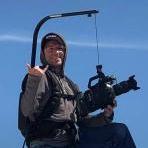
BrooklynDan
-
Posts
184 -
Joined
-
Last visited
Reputation Activity
-
 BrooklynDan got a reaction from Sebastien Farges in AIVASCOPE 1.5x anamorphic lens, 1st hands-on !!!!
BrooklynDan got a reaction from Sebastien Farges in AIVASCOPE 1.5x anamorphic lens, 1st hands-on !!!!
Looks pretty sharp. Apparently, it was optimized for full frame sensors, so it can handle M4/3 no sweat. The built-in focus gear, close focus and non-rotating front makes it more practical than the Iscorama ever was. Looks like a win!
-
 BrooklynDan got a reaction from currensheldon in Panasonic FF L-mount Cine camera coming
BrooklynDan got a reaction from currensheldon in Panasonic FF L-mount Cine camera coming
I kind of wish that Panasonic would've let go of the mirrorless form factor for this camera. Strictly speaking, there is no good reason to give a purpose-built video camera a mirrorless-style body. It does not really fit with the way people operate cinema cameras. As a hybrid between still and video, OK. But for a dedicated cinema camera, I would've much preferred a LS300/VG900 camcorder-style body. It would make it much easier to accommodate the inevitable PL mount adaptors and pro battery plates. Also, XLR inputs and audio controls.
-
 BrooklynDan got a reaction from JordanWright in Panasonic FF L-mount Cine camera coming
BrooklynDan got a reaction from JordanWright in Panasonic FF L-mount Cine camera coming
I kind of wish that Panasonic would've let go of the mirrorless form factor for this camera. Strictly speaking, there is no good reason to give a purpose-built video camera a mirrorless-style body. It does not really fit with the way people operate cinema cameras. As a hybrid between still and video, OK. But for a dedicated cinema camera, I would've much preferred a LS300/VG900 camcorder-style body. It would make it much easier to accommodate the inevitable PL mount adaptors and pro battery plates. Also, XLR inputs and audio controls.
-
 BrooklynDan got a reaction from DBounce in Panasonic FF L-mount Cine camera coming
BrooklynDan got a reaction from DBounce in Panasonic FF L-mount Cine camera coming
I kind of wish that Panasonic would've let go of the mirrorless form factor for this camera. Strictly speaking, there is no good reason to give a purpose-built video camera a mirrorless-style body. It does not really fit with the way people operate cinema cameras. As a hybrid between still and video, OK. But for a dedicated cinema camera, I would've much preferred a LS300/VG900 camcorder-style body. It would make it much easier to accommodate the inevitable PL mount adaptors and pro battery plates. Also, XLR inputs and audio controls.
-
 BrooklynDan got a reaction from leslie in Bausch and Lomb Cinemascope Camera Attachment lens
BrooklynDan got a reaction from leslie in Bausch and Lomb Cinemascope Camera Attachment lens
It's the very first anamorphic lens attachment ever built for cinematography. Before this, there was Henri Chretien's original optic. It is obviously double-focus only, as a variable diopter on top would need to be massive. Maybe one of these new wireless units from PD Movie could be calibrated to synchronize the focus movement with a prime lens. I do believe that this worked down to 40mm on standard 35mm. It was used with original Baltars from B&L.
-
 BrooklynDan got a reaction from Junior in Moller 30 - help needed
BrooklynDan got a reaction from Junior in Moller 30 - help needed
The blue part looks like a simple Double Gauss prime lens. Maybe Zeiss or Kinoptik. The grey tabs on top and bottom are probably the focusing levers. I can't guess from this schematic how the taking lens and anamorphic lens was synchronized, but if the helicals are cut right, a bridge between the focusing tabs might be able to pull off dual focus in one movement.
This is a Totalvision adapter (circa France 1960) that's similar in design and construction:
https://www.ebay.com/itm/Totalvision-Anamorphic-Cine-Lens-made-in-france-/113426233375
It was used with a set of four Speed Panchro primes from 40mm to 100mm mechanically linked to the adapter via the focusing lever. I'm guessing that your Moller works similarly.
Either way, let's see a lens test!
-
 BrooklynDan got a reaction from Junior in Moller 30 - help needed
BrooklynDan got a reaction from Junior in Moller 30 - help needed
It was almost certainly used with either Cooke Speed Panchro or Kinoptik taking lenses. Probably 40,50,75 and 100mm. All the early European 'Scope (Dyaliscope, Totalvision, CinePanoramic) systems used either one or the other. It's most likely pretty sharp since the glass is so big. Would love to see a test, both at infinity and close focus.
-
 BrooklynDan got a reaction from tupp in Cinemartin Fran 8K Global Shutter Camera
BrooklynDan got a reaction from tupp in Cinemartin Fran 8K Global Shutter Camera
Even if it does make it to market, it is the worst-designed camera body I've ever seen. It makes the original Red One (a clunky, heavy, loaf-shaped turd with non-sensical UI) look like a masterpiece of industrial design. Holy fuck, who puts a screen on top? Where am I supposed to attach a handle?
-
 BrooklynDan got a reaction from Nikkor in What is the medium format look?
BrooklynDan got a reaction from Nikkor in What is the medium format look?
It must be said that video amplifies the difference between formats far more than in stills. Once you add camera movement and focus pulling, the advantages of a larger sensor become crystal clear. Watch any film shot on Alexa 65. There's more gentle falloff, less distortion in wide shots, crisper more intimate close-ups, more apparent depth and more detail but without clinical sharpness.
-
 BrooklynDan got a reaction from IronFilm in Ode To the Beloved Sony FS100
BrooklynDan got a reaction from IronFilm in Ode To the Beloved Sony FS100
I simply do not understand the nostalgia here. I shot my senior thesis project on an FS100 and while I got some decent images out of it thanks to the skill of my DP, it always looked very videoish to me. The highlights burned horribly, the colors were oversaturated, and even if you shot it flat, you could never quite bring it back to the way you want it in post. Also, the form factor and ergonomics were some of the worst I have ever seen, the placement of the LCD screen on top was ludicrous, and the lack of NDs (thankfully rectified in the FS700) made screw-ons or matteboxes a necessity, which is difficult on a zero-budget. It was Sony's first go at making a prosumer large-sensor camera (after the F3 which came out at the same time), and their lack of common sense and feel for camera design just wasn't there, despite their long history in making video equipment.
My C100 mk. I(same era, same price-range) eats it for lunch in every possible way. Image quality, roll-off, NDs, hand-holdable ergonomics, etc.
-
 BrooklynDan got a reaction from jbCinC_12 in Ode To the Beloved Sony FS100
BrooklynDan got a reaction from jbCinC_12 in Ode To the Beloved Sony FS100
I simply do not understand the nostalgia here. I shot my senior thesis project on an FS100 and while I got some decent images out of it thanks to the skill of my DP, it always looked very videoish to me. The highlights burned horribly, the colors were oversaturated, and even if you shot it flat, you could never quite bring it back to the way you want it in post. Also, the form factor and ergonomics were some of the worst I have ever seen, the placement of the LCD screen on top was ludicrous, and the lack of NDs (thankfully rectified in the FS700) made screw-ons or matteboxes a necessity, which is difficult on a zero-budget. It was Sony's first go at making a prosumer large-sensor camera (after the F3 which came out at the same time), and their lack of common sense and feel for camera design just wasn't there, despite their long history in making video equipment.
My C100 mk. I(same era, same price-range) eats it for lunch in every possible way. Image quality, roll-off, NDs, hand-holdable ergonomics, etc.
-
 BrooklynDan got a reaction from webrunner5 in Ode To the Beloved Sony FS100
BrooklynDan got a reaction from webrunner5 in Ode To the Beloved Sony FS100
I simply do not understand the nostalgia here. I shot my senior thesis project on an FS100 and while I got some decent images out of it thanks to the skill of my DP, it always looked very videoish to me. The highlights burned horribly, the colors were oversaturated, and even if you shot it flat, you could never quite bring it back to the way you want it in post. Also, the form factor and ergonomics were some of the worst I have ever seen, the placement of the LCD screen on top was ludicrous, and the lack of NDs (thankfully rectified in the FS700) made screw-ons or matteboxes a necessity, which is difficult on a zero-budget. It was Sony's first go at making a prosumer large-sensor camera (after the F3 which came out at the same time), and their lack of common sense and feel for camera design just wasn't there, despite their long history in making video equipment.
My C100 mk. I(same era, same price-range) eats it for lunch in every possible way. Image quality, roll-off, NDs, hand-holdable ergonomics, etc.
-
 BrooklynDan got a reaction from webrunner5 in Cinemartin Fran 8K Global Shutter Camera
BrooklynDan got a reaction from webrunner5 in Cinemartin Fran 8K Global Shutter Camera
Even if it does make it to market, it is the worst-designed camera body I've ever seen. It makes the original Red One (a clunky, heavy, loaf-shaped turd with non-sensical UI) look like a masterpiece of industrial design. Holy fuck, who puts a screen on top? Where am I supposed to attach a handle?
-
 BrooklynDan got a reaction from BenEricson in C100 Mark ii in 2018
BrooklynDan got a reaction from BenEricson in C100 Mark ii in 2018
I heart my C100 mk 1. Still the most cinematic image you can get for the money. Dslrs and Mirrorless cameras just don't have the same level of richness and depth to the colors.
-
 BrooklynDan got a reaction from Geoff CB in Arri D21
BrooklynDan got a reaction from Geoff CB in Arri D21
I saw one for sale at Arri Rental complete with OB-1 recorder for $6K. As tempting as the image quality and low price are, it is far too cumbersome and heavy to be practical. It's also very power-hungry and just try getting a quote on maintenance. Just the spinning mirror assembly costs thousands. It was a $200K item new.
Now that original Alexas are dipping under $10k and will soon be even cheaper, there is no real reason to use a D21.
-
 BrooklynDan got a reaction from Django in "Classic" digital look
BrooklynDan got a reaction from Django in "Classic" digital look
The Canon XL2 was a fabulous camera. I still wish that Canon would release a Super 35mm camera in that form factor. It reminds me of an Aaton or Eclair film camera. Off the tripod, on the shoulder. And the colors were excellent.
In that same vein, I also look upon the DVX100 fondly. That first generation of 24p DV had some kind of special sauce.
I own a C100 mk. 1 and while it's not yet vintage, I think that people will keep shooting with it long into the 4K, 8K, 16K, etc age. A lot of soul and charm in a small package.
-
 BrooklynDan got a reaction from mercer in "Classic" digital look
BrooklynDan got a reaction from mercer in "Classic" digital look
The Canon XL2 was a fabulous camera. I still wish that Canon would release a Super 35mm camera in that form factor. It reminds me of an Aaton or Eclair film camera. Off the tripod, on the shoulder. And the colors were excellent.
In that same vein, I also look upon the DVX100 fondly. That first generation of 24p DV had some kind of special sauce.
I own a C100 mk. 1 and while it's not yet vintage, I think that people will keep shooting with it long into the 4K, 8K, 16K, etc age. A lot of soul and charm in a small package.
-
 BrooklynDan got a reaction from JordanWright in Has Panasonic Killed Off Cinema Lenses?
BrooklynDan got a reaction from JordanWright in Has Panasonic Killed Off Cinema Lenses?
True cinema lenses are not dead by any means. I don't know of any ACs that would like to pull focus from a smart phone. At the rental house where I work, we have invested heavily in Preston and Arri wireless gear. You'll pry the Hand Unit 3 from my cold dead hands.
That said, there is a need to cut down on the gunk that hangs off of cameras, as you can see in this picture. The latest generation of Panavision's DXL has a Preston receiver built in and the Primo 70 lenses have lens motors for focus and iris directly inside the lens barrel. So I think that there will be more integration in the future. That said, DSLR-level technology is just not gonna fly on a pro set. Your Panasonic lenses are gonna get destroyed easily. Also, I don't think that anybody wants to let go of human focus-pulling. It's a hard job and it gets harder as sensors get bigger. But it remains an organic, vital part of image-making, and I don't think that machines are gonna be able to deliver that.
-
 BrooklynDan got a reaction from tupp in Full Frame F65 replacement in 2018?
BrooklynDan got a reaction from tupp in Full Frame F65 replacement in 2018?
This has been known for a while now. They are developing it with input from cinematographers and post houses. It's going to take advantage of Sony X-OCN compressed raw format in order to bring file sizes under control. One of the Achilles' heels of the F65 was the fact that the file sizes were massive. And with 8K, it's even more important to provide efficient compression.When data rates go into the terabytes/hr range, data management becomes feasible for only the really big productions.
Word on the street is that it will be compatible with Sony's R7 raw recorder, which indicates that the camera will share the F5/F55 form factor and that's a big step forward. Those are well-sized and shaped cameras. The F65 was an ungainly beast.
-
 BrooklynDan got a reaction from Justin Bacle in AGASCOPE - worth buying?
BrooklynDan got a reaction from Justin Bacle in AGASCOPE - worth buying?
In theory, it is worth that price because it is a professional-grade anamorphic prime lens, and similar lenses from Lomo and others have been going for about $8k. However, I think the value of this lens should take a hit because it is, of course, a one-off. The chances of building a complete Agascope set are slim to none, So that makes this lens a curiosity, rather than a functional cinema lens, and it should be priced as such. I would put it at $4-5k.
-
 BrooklynDan got a reaction from Timotheus in AGASCOPE - worth buying?
BrooklynDan got a reaction from Timotheus in AGASCOPE - worth buying?
It is an AgaScope lens. It was built by a Swedish industrial firm during the widescreen craze of the late 50s/early 60s. It was mainly used in Sweden, although some sets made it to Eastern Europe. The set was fairly sparse and included a 46mm and a 75mm. There weren't any zooms or wide focal lengths available, so the modern day appeal of these lenses is limited. Quality should be on par with other early anamorphic systems of continental Europe like Dyaliscope or Totalvision.
-
 BrooklynDan got a reaction from webrunner5 in AGASCOPE - worth buying?
BrooklynDan got a reaction from webrunner5 in AGASCOPE - worth buying?
It is an AgaScope lens. It was built by a Swedish industrial firm during the widescreen craze of the late 50s/early 60s. It was mainly used in Sweden, although some sets made it to Eastern Europe. The set was fairly sparse and included a 46mm and a 75mm. There weren't any zooms or wide focal lengths available, so the modern day appeal of these lenses is limited. Quality should be on par with other early anamorphic systems of continental Europe like Dyaliscope or Totalvision.
-
 BrooklynDan got a reaction from Justin Bacle in AGASCOPE - worth buying?
BrooklynDan got a reaction from Justin Bacle in AGASCOPE - worth buying?
It is an AgaScope lens. It was built by a Swedish industrial firm during the widescreen craze of the late 50s/early 60s. It was mainly used in Sweden, although some sets made it to Eastern Europe. The set was fairly sparse and included a 46mm and a 75mm. There weren't any zooms or wide focal lengths available, so the modern day appeal of these lenses is limited. Quality should be on par with other early anamorphic systems of continental Europe like Dyaliscope or Totalvision.
-
 BrooklynDan got a reaction from Tito Ferradans in Cameras With 4:3 Anamorphic Mode?
BrooklynDan got a reaction from Tito Ferradans in Cameras With 4:3 Anamorphic Mode?
I think that it's important to look less at the specific aspect ratio of the sensor than at the height of the sensor, especially when it comes to using professional anamorphic lenses. When shooting for a 2.40 aspect ratio, having a taller sensor means using more of the field of view of the lens. And this comes into play when using older lenses that may not have the wide angle options, or have wide angle lenses that are unusually large or oddly shaped. At my job, I have compared Lomo anamorphics on the Alexa (18x24mm sensor) and the Red Dragon (15x30mm sensor). On the Alexa, you can more or less get way with using the 50mm as your widest lens. On the Red, the 50mm is more like a 60mm, and you're gonna be relying more on the 35mm Lomo, which is a big heavy lens with a giant front diameter, and a lot more barrel distortion and softer edges. It's just more practical to have a sensor that matches the full height of the 35mm academy format, regardless of whether it is 4:3 or not. And with how high resolution have gotten lately, there's no need to fear cropping. No use crying over spilled pixels.
-
 BrooklynDan got a reaction from elgabogomez in Cameras With 4:3 Anamorphic Mode?
BrooklynDan got a reaction from elgabogomez in Cameras With 4:3 Anamorphic Mode?
I think that it's important to look less at the specific aspect ratio of the sensor than at the height of the sensor, especially when it comes to using professional anamorphic lenses. When shooting for a 2.40 aspect ratio, having a taller sensor means using more of the field of view of the lens. And this comes into play when using older lenses that may not have the wide angle options, or have wide angle lenses that are unusually large or oddly shaped. At my job, I have compared Lomo anamorphics on the Alexa (18x24mm sensor) and the Red Dragon (15x30mm sensor). On the Alexa, you can more or less get way with using the 50mm as your widest lens. On the Red, the 50mm is more like a 60mm, and you're gonna be relying more on the 35mm Lomo, which is a big heavy lens with a giant front diameter, and a lot more barrel distortion and softer edges. It's just more practical to have a sensor that matches the full height of the 35mm academy format, regardless of whether it is 4:3 or not. And with how high resolution have gotten lately, there's no need to fear cropping. No use crying over spilled pixels.











